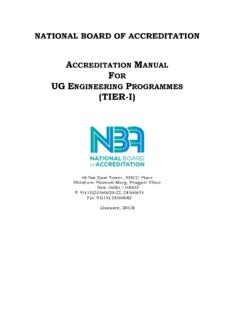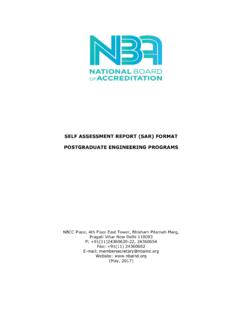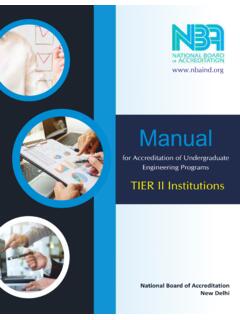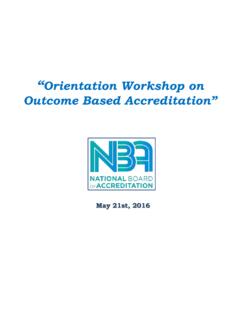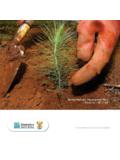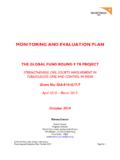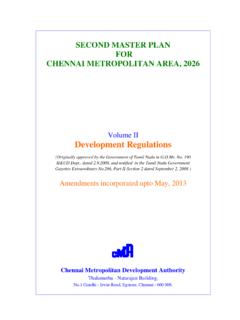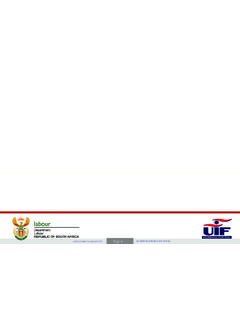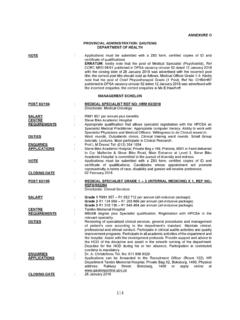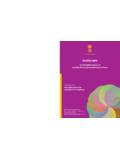Transcription of SELF ASSESSMENT REPORT (SAR) FORMAT …
1 1 SELF ASSESSMENT REPORT (SAR) FORMAT undergraduate engineering programs ( tier -I) FIRST TIME ACCREDITATION (Applicable for all the programs , except those granted full accreditation for 5 years as per Jan 2013 Manual) NBCC Place, 4th Floor East Tower, Bhisham Pitamah Marg, Pragati Vihar New Delhi 110003 P: +91(11)24360620-22, 24360654 Fax: +91(11) 24360682 E-mail: Website: (December, 2015) 2 SAR Contents Serial Code & Link to the Item Item Page No. PART A Institutional Information 3-6 PART B Criteria Summary 7 Program Level Criteria 1 Vision, Mission and Program Educational Objectives 8 2 Program Curriculum and Teaching Learning Processes 9-10 3 Course Outcomes and Program Outcomes 11-13 4 Students Performance 14-19 5 Faculty Information and Contributions 20-25 6 Facilities and Technical Support 26 7 Continuous Improvement 27 - 30 Institute Level Criteria 8 First Year Academics 31 - 34 9 Student Support Systems 35 10 Governance, Institutional Support and Financial Resources 36 - 40 PART C Declaration by the Institution 41 Annexure I Program Outcomes(POs) & Program Specific Outcomes (PSOs) 42 3 PART A: Institutional Information 1.
2 Name and Address of the Institution: 2. Name and Address of the Affiliating University: 3. Year of establishment of the Institution: 4. Type of the Institution: Institute of National Importance University Deemed University Autonomous Any other (Please specify) Note: 1. In case of Autonomous and Deemed University, mention the year of grant of status by the authority. 2. In case of University Constituent Institution, please indicate the academic autonomy status of the Institution as defined in 12th Plan guidelines of UGC. Institute should apply for tier 1 only when fully academically autonomous. 5. Ownership Status: Central Government State Government Government Aided Self - financing Trust Society Section 25 Company Any Other (Please specify) Provide Details: 4 6. Other Academic Institutions of the Trust/Society/Company etc., if any: Name of the Institution(s) Year of Establishment programs of Study Location Table Note: Add rows as needed.
3 7. Details of all the programs being offered by the institution under consideration: S. No. Program Name Name of the Department Year of Start Intake Increase/Decrease in intake, if any Year of Increase/Decrease AICTE Approval Accreditation Status* Table * Write applicable one: Applying first time Granted provisional accreditation for two/three years for the period(specify period) Granted accreditation for 5/6 years for the period (specify period) Not accredited (specify visit dates, year) Withdrawn (specify visit dates, year) Not eligible for accreditation Eligible but not applied Note: Add rows as needed. 8. programs to be considered for Accreditation vide this application S. No. Program Name 1 N. Table 9. Total number of employees: A. Regular Employees (Faculty and Staff): Items CAY CAYm1 CAYm2 Min Max Min Max Min Max Faculty in engineering M F 5 Faculty in Maths, Science &Humanities teaching in engineering programs M F Non-teaching staff M F Table Note: Minimum 75% should be Regular/Full Time faculty and the remaining shall be Contractual Faculty as per AICTE norms and standards.
4 The contractual faculty (doing away with the terminology of visiting/adjunct faculty, whatsoever) who have taught for 2 consecutive semesters in the corresponding academic year on full time basis shall be considered for the purpose of calculation in the Student Faculty Ratio. CAY Current Academic Year CAYm1- Current Academic Year minus1= Current ASSESSMENT Year CAYm2 - Current Academic Year minus2=Current ASSESSMENT Year minus 1 B. Contractual Staff Employees (Faculty and Staff): (Not covered in Table A): Items CAY CAYm1 CAYm2 Min Max Min Max Min Max Faculty in engineering M F Faculty in Maths, Science &Humanities teaching in engineering programs M F Non-teaching staff M F Table 10. Total number of engineering Students: Item CAY CAYm1 CAYm2 Total no. of boys Total no. of girls Total no. of students Table (Instruction: The data may be categorized in tabular form separately for undergraduate , postgraduate engineering , other program, if applicable) Note: In case the institution is running programs other than engineering programs , a separate table giving similar details is to be included.
5 6 11. Vision of the Institution: 12. Mission of the Institution: 13. Contact Information of the Head of the Institution and NBA coordinator, if designated: i. Name: Designation: Mobile No: Email id: ii. NBA coordinator, if designated Name: Designation: Mobile No: Email id: 7 PART B: Criteria Summary Name of the program _____ Criteria No. Criteria Mark/Weightage Program Level Criteria 1. Vision, Mission and Program Educational Objectives 50 2. Program Curriculum and Teaching Learning Processes 100 3. Course Outcomes and Program Outcomes 175 4. Students Performance 100 5. Faculty Information and Contributions 200 6. Facilities and Technical Support 80 7. Continuous Improvement 75 Institute Level Criteria 8. First Year Academics 50 9. Student Support Systems 50 10. Governance, Institutional Support and Financial Resources 120 Total 1000 8 PART B: Program Level Criteria CRITERION 1 Vision, Mission and Program Educational Objectives 50 State the Vision and Mission of the Department and Institute (5) (Vision statement typically indicates aspirations and Mission statement states the broad approach to achieve aspirations) (Here Institute Vision and Mission statements have been asked to ensure consistency with the department Vision and Mission statements; the ASSESSMENT of the Institute Vision and Mission will be taken up in Criterion 10) State the Program Educational Objectives (PEOs) (5) (State the PEOs (3 to 5) of program seeking accreditation) Indicate where the Vision, Mission and PEOs are published and disseminated among stakeholders (15) (Describe where (websites, curricula, posters etc.))
6 The Vision, Mission and PEOs are published and detail the process which ensures awareness among internal and external stakeholders with effective process implementation) (Internal stakeholders may include Management, Governing Board Members, faculty, support staff, students etc. and external stakeholders may include employers, industry, alumni, funding agencies, etc.) State the process for defining the Vision and Mission of the Department, and PEOs of the program (15) (Articulate the process involved in defining the Vision and Mission of the department and PEOs of the program.) Establish consistency of PEOs with Mission of the Department (10) (Generate a Mission of the Department PEOs matrix with justification and rationale of the mapping) PEO Statements M1 M2 .. Mn PEO1: PEO2: PEON: Table Note: M1, M2.. Mn are distinct elements of Mission statement. Enter correlation levels 1, 2 or 3 as defined below: 1: Slight (Low) 2: Moderate (Medium) 3: Substantial (High) If there is no correlation, put - Note.
7 Wherever the word process is used in this document its meaning is process formulation, notification to all the concerned, and implementation 9 CRITERION 2 Program Curriculum and Teaching Learning Processes 100 Program Curriculum (30) State the process for designing the program curriculum (10) (Describe the process that periodically documents and demonstrates how the program curriculum is evolved considering the POs and PSOs) Structure of the Curriculum (5) Course Code Course Title Total Number of contact hours Credits Lecture (L) Tutorial (T) Practical# (P) Total Hours Total Table # Seminars, project works may be considered as practical State the components of the curriculum (5) Program curriculum grouping based on course components Course Component Curriculum Content (% of total number of credits of the program ) Total number of contact hours Total number of credits Basic Sciences engineering Sciences Humanities and Social Sciences Program Core Program Electives Open Electives Project(s) Internships/Seminars Any other (Please specify) Total number of Credits Table 10 State the process used to identify extent of compliance of the curriculum for attaining the Program Outcomes and Program Specific Outcomes as mentioned in Annexure I (10) (State the process details) Teaching-Learning Processes (70) Describe Processes followed to improve quality of Teaching & Learning (15) (Processes may include adherence to academic calendar and improving instruction methods using pedagogical initiatives such as real world examples, collaborative learning, quality of laboratory experience with regard to conducting experiments, recording observations, analysis of data etc.)
8 Encouraging bright students, assisting weak students etc. The implementation details and impact analysis need to be documented) Quality of end semester examination, internal semester question papers, assignments and evaluation (15) (Mention the initiatives, implementation details and analysis of learning levels related to quality of semester tests, assignments and evaluation) Quality of student projects (20) (Quality of the project is measured in terms of consideration to factors including, but not limited to, environment, safety, ethics, cost, type (application, product, research, review etc.) and standards. Processes related to project identification, allotment, continuous monitoring, evaluation including demonstration of working prototypes and enhancing the relevance of projects. Mention Implementation details including details of POs and PSOs addressed through the projects with justification) Initiatives related to industry interaction (10) (Give details of the industry involvement in the program such as industry-attached laboratories, partial delivery of appropriate courses by industry experts etc.
9 Mention the initiatives, implementation details and impact analysis) Initiatives related to industry internship/summer training (10) (Mention the initiatives, implementation details and impact analysis) 11 CRITERION 3 Course Outcomes and Program Outcomes 175 Establish the correlation between the courses and the Program Outcomes (POs) & Program Specific Outcomes (25) NBA defined Program Outcomes as mentioned in Annexure I and Program Specific Outcomes as defined by the Program. Six to ten matrices of core courses are to be mentioned with at least one per semester. Select core courses to demonstrate the mapping/correlation with all POs and PSOs. Number of Outcomes for a Course is expected to be around 6. Program Articulation Matrix Course PO1 PO2 PO3 PO4 PO5 PO6 PO7 PO8 PO9 PO10 PO11 PO12 C101 C202 C303 .. Table Course Articulation Matrix CO Statement PO1 PO2 PO3 PO4 PO5 PO6 PO7 PO8 PO9 PO10 PO11 PO12 C202 Table Add and delete rows for Course Outcomes as needed Note: 1.
10 Enter correlation levels 1, 2 or 3 as defined below: 1: Slight (Low) 2: Moderate (Medium) 3: Substantial (High) 12 If there is no correlation, put - 2. Add more columns for PSOs 3. The table can be prepared in landscape mode if required. Attainment of Course Outcomes (75) Describe the ASSESSMENT tools and processes used to gather the data upon which the evaluation of Course Outcome is based (10) Describe different ASSESSMENT tools (semester end examinations, mid-semester tests, laboratory examinations, student portfolios etc) to measure the student learning and hence attainment of course outcomes. (Student portfolio is a collection of artifacts that demonstrate skills, personal characteristics and accomplishments created by the student during study period.) The process adopted to map the ASSESSMENT questions, parameters of ASSESSMENT rubrics etc. to the course outcomes to be explained with examples. The process of data collection from different ASSESSMENT tools and the analysis of collected data to arrive at CO attainment levels need to be explained with examples Record the attainment of Course Outcomes of all courses with respect to set attainment levels (65) Program shall set Course Outcome attainment levels for all courses.
